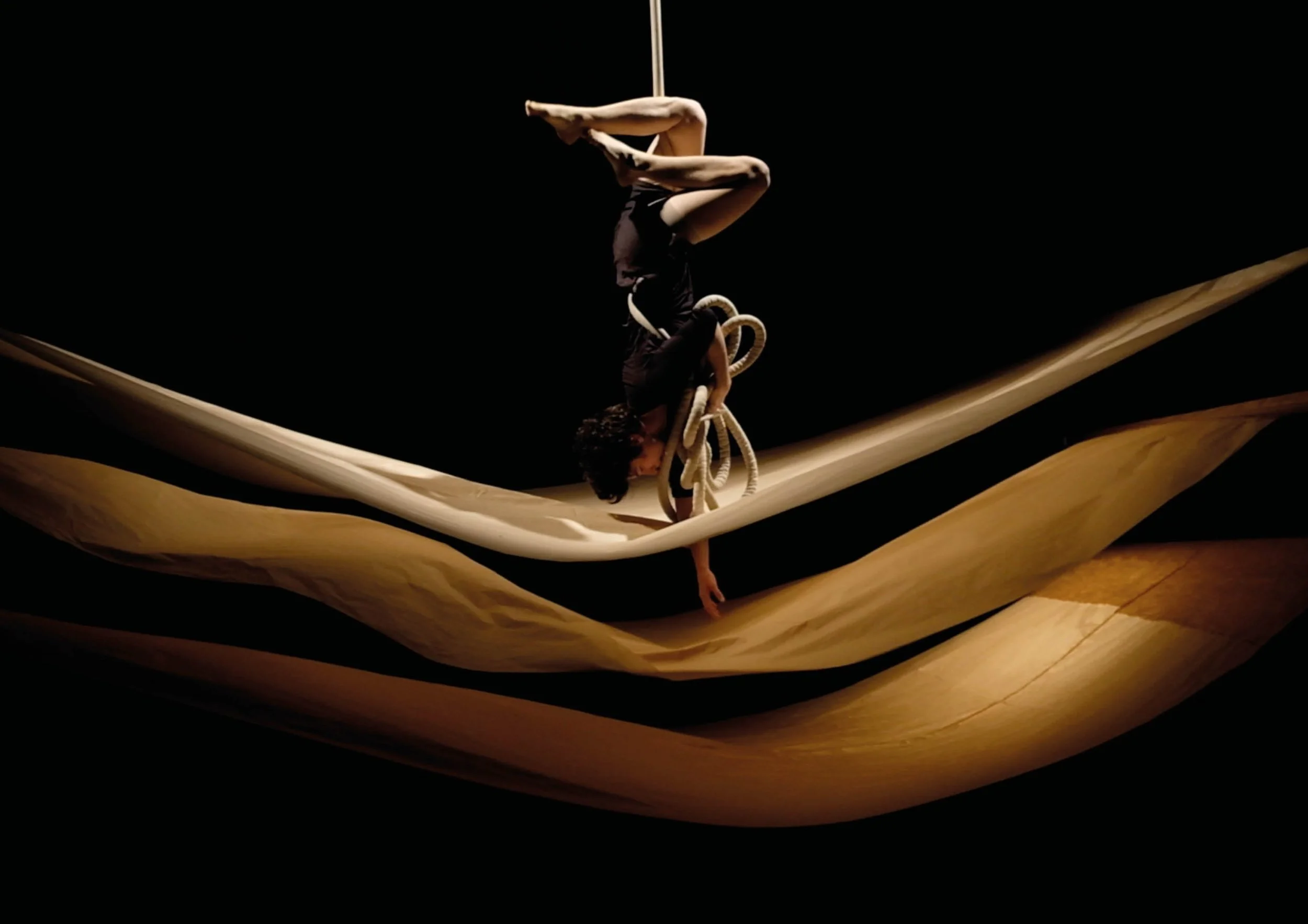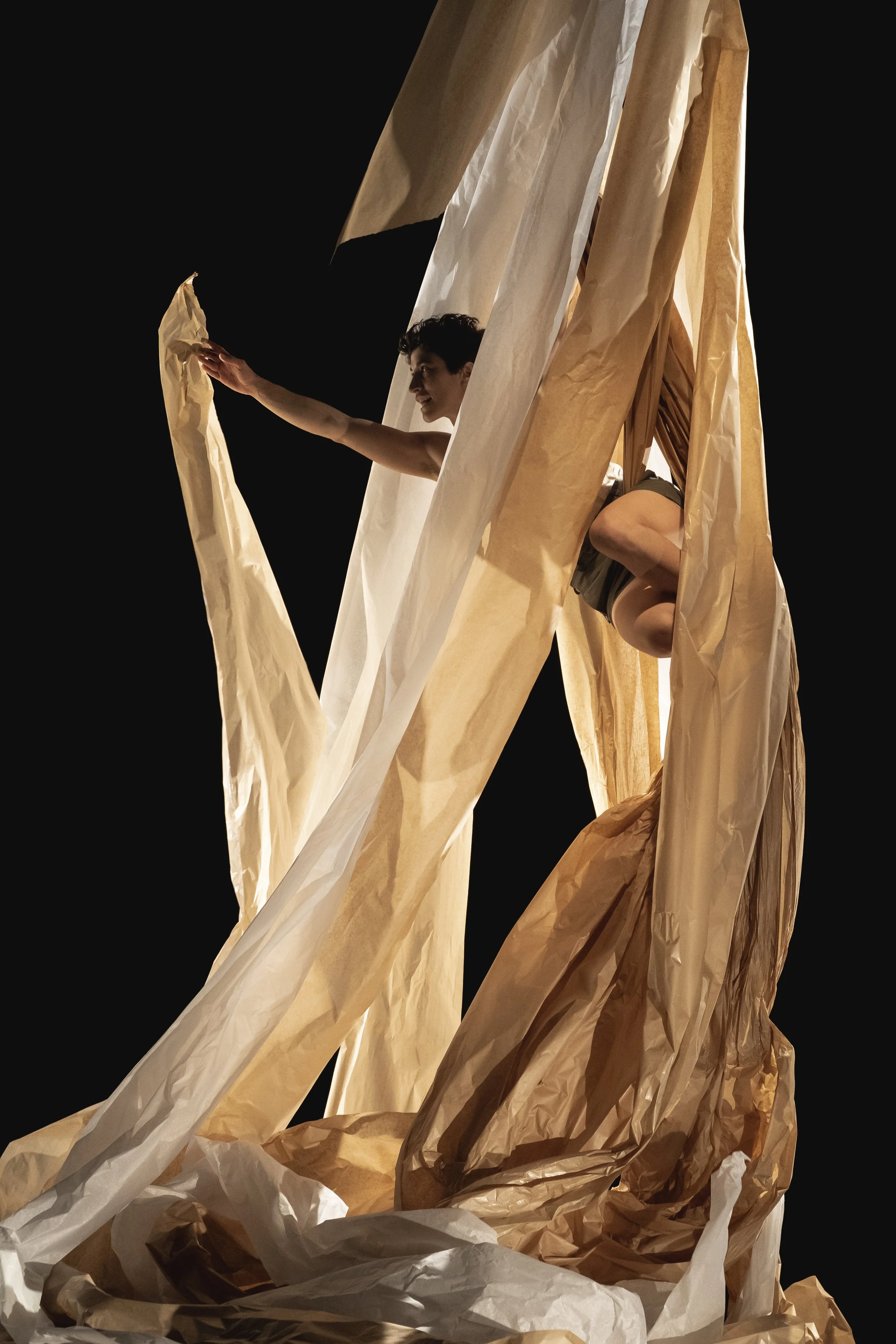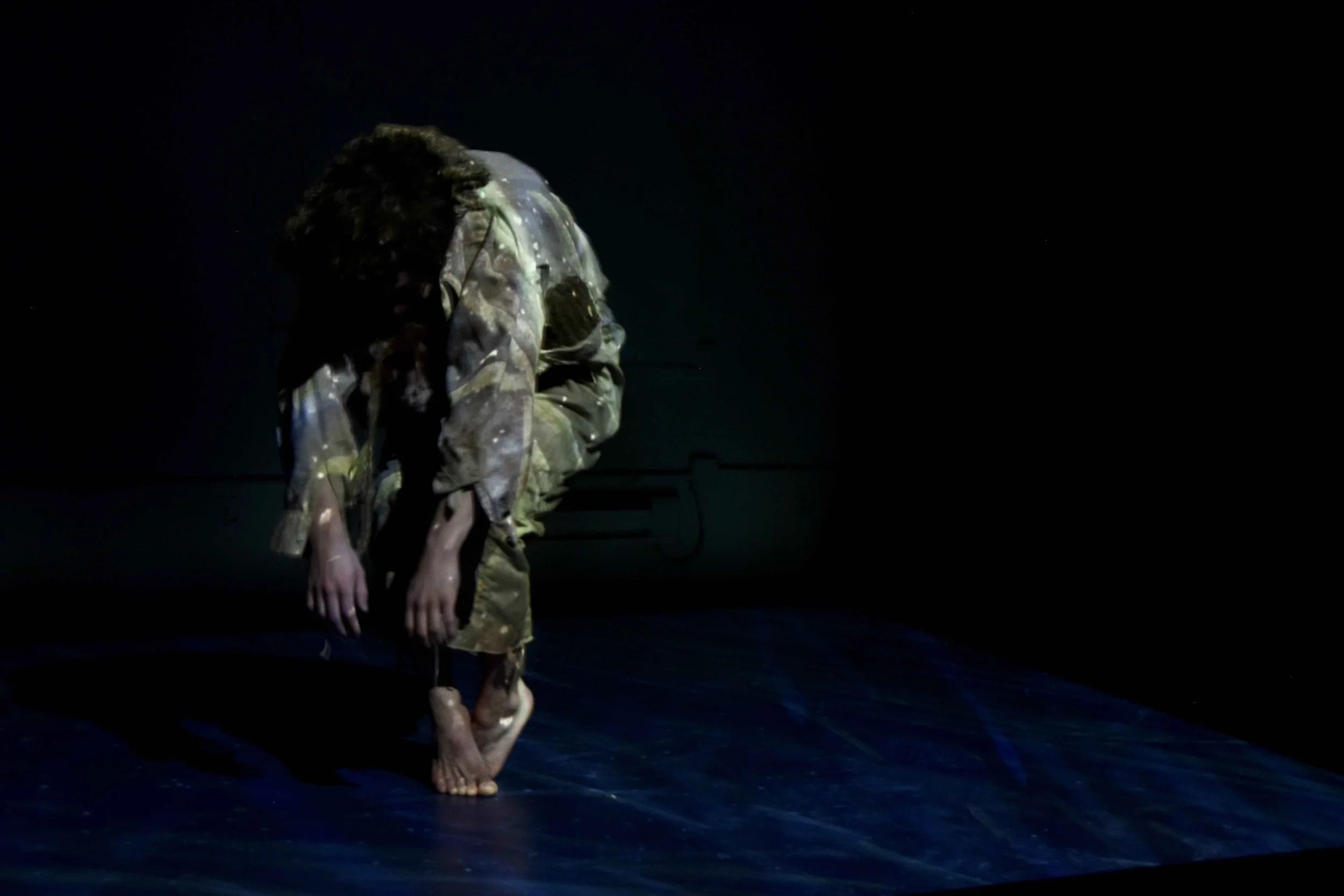Dance review: In Les SUBS' Pli, paper is a jumpsuit, a tug-of-war rope, and a vessel for the seemingly impossible
At PuSh Festival, artists play off themes of strength and fragility by using paper for aerial stunts
Inbal Ben Haim in Pli. Photo by Domitille Martin
PuSh International Performing Arts Festival and Chutzpah! Festival present Les SUBS’s Pli to February 4 online
AT ONE POINT in Les SUBS’ thrilling dance-circus piece Pli, Inbal Ben Haim begins climbing sheets of brown and white paper that have been tied together and suspended from the rafters. As she scales the material ever-higher, a sense of danger is imminent. How has the paper, in all its fragility, suddenly become strong enough to hold a dancer’s body weight?
Hanging nearly 20 feet above the Vancouver Playhouse stage floor, Ben Haim entangles her limbs in the paper sheets. Suddenly, she rips off one of the strands holding her up—causing the audience to let out a collective gasp—and lets it float to the ground. Then she tears off another, and another, and another, until she’s impossibly suspended, with no connection back down to the stage floor.
Ben Haim hangs upside-down, letting her arms dangle, then ripping off one last bit of paper when it looks like there’s nothing left to lose. (Here, a viewer lets out a nervous scream—the suspense is killer.) She fidgets indecisively for what feels like forever, and finally drops onto a mattress below to immense applause.
The moment in Pli is just one of dozens that have the audience engaged to the fullest extent. While onlookers tense up in fear, Jerusalem-born, France-based circus artist Ben Haim exudes confidence. She appears right at home in the air—and it’s exhilarating.
Ben Haim is joined onstage by two French collaborators, sculptor–visual artist Domitille Martin and dancer–circus artist Alvaro Valdes. They begin the show by using thick rolls of paper to make an aerial circus set from scratch. The trio are focused and methodical; different ropes and harnesses take shape before the viewers’ eyes. Crafting takes up what seems like half of the hour-long performance, and though it’s admittedly a long process, it’s imperative to the audience’s understanding. We can clearly see that there is no “stage magic” taking place, no cheating, no faking what is about to unfold.
Inbal Ben Haim in Pli. Photo by Loïc Nys
Paper soon becomes the grounds for imaginative exploration. At one point, the dancers play tug-of-war to pull a paper rope taut, testing its strength. Later, paper confetti launches into the air and floats delicately to the ground. Then, towering bundles of paper strips are raised into the sky like surreal jellyfish; Valdes uses a flat square of cardboard to swing at the strips, and they bounce up with wind force as an electric shock noise plays over the speakers.
Pli is a sensory delight for the ears as well as the eyes, complete with meaty crumpling, gentle fluttering, and crisp tearing. Sound creator Max Bruckert integrates noises that amplify each scene: a rock bouncing through a tin pipe, a thundering heartbeat, a series of deep breaths.
Ben Haim’s strength as a performer is evident in even the smallest of instances. Near the beginning of the piece, there’s a roll of paper suspended from the ceiling that the artist stands on as if she’s in a logrolling competition on water. She balances there for what feels like an eternity, her feet arched over the roll, her hands out beside her for stability. Her sense of equilibrium while in this position is near superhuman.
When the stage floor is filled with paper—flat sheets, crinkled piles, scrunched-up balls—Ben Haim, Domitille, and Valdes suddenly peel up a huge piece of paper that had been covering the floor, and roll up all the material into a massive wall of sorts upstage. Domitille stares at the mound, calculating her next move, and then runs at it full-force, flinging herself into the pile. She resurfaces, leaving a peculiar body indent behind, before repeating the action a few more times in other spots. The action is uber-satisfying, and executed with lovely intention given that Domitille is a visual artist, not a dancer.
Perhaps the most stunning moment of the performance is the simplest. After being offstage briefly, Ben Haim emerges from the wings outfitted in a head-to-toe paper jumpsuit, walkingly rigidly. She stands before the audience and breathes. With small twitches of the body, the jumpsuit begins to tear. Ben Haim uses minute, insect-like movements—quick shoulder rolls, wrist flicks, and torso shifts—to shed the skin, even reaching her head down to bite a few pieces off, until she stands before the audience in nothing but nude undergarments. She is completely unrestrained by her environment.
What’s really evident throughout Pli is the sheer freedom Ben Haim emanates. Accompanying that sense of boldness, though, are clever call-and-response actions with the paper: she pauses after big weight transfers to listen for rips.
Ben Haim’s manipulation of material truly goes beyond the imaginable, allowing Pli to completely redefine paper in the eyes of the beholder. The commentary on preconceived notions of strength and fragility is especially impactful here—who knew paper could suspend a moving body 20 feet in the air? For those of us who aren’t circus artists, though, it might be best to stick to writing on paper rather than climbing it.















